David Tickner's Blog, page 8
January 25, 2024
Stool
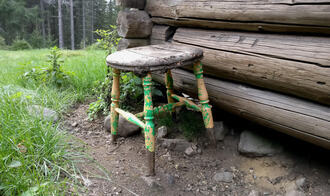 What kind of response do you think you would get if you went into a furniture store and asked to see some stool samples?!
What kind of response do you think you would get if you went into a furniture store and asked to see some stool samples?!The word stool has its origins in Proto-Indo-European (PIE) sta-lo (to stand, to make firm). From this source came Proto-Germanic stola and Old English stol (a seat for one person).
The Old English word cynestol (a king’s seat; cyne + stol) referred to a throne. The use of stol meaning a seat fell from favor in the medieval period with the introduction of the word chair from French. (If not for William the Conqueror, we might now be using the term stoolperson instead of chairperson.)
After the 14th century, a stool was simply a small seat without arms or backs, sometimes just a piece of wood mounted on three legs. By the early 15th century, such a stool was often relegated to a privy (a private space).
Speaking of a privy, how did the word stool come to mean the product of a bowel movement? Perhaps it was more polite to say stool (where you sat) than to say the words, polite or otherwise, for what you produced while you sat. By the 1530s, stool was a euphemism for a b.m.
The word privy, from around 1200, referring to a latrine or outhouse, is from Latin privatus (private, personal).
And, if you’re looking for a stool and you’ve got some spare cash, check out a 1960’s Charlotte Perriand Wooden Stool (used), on sale for $CA6,718.96.
Reference: Online Etymological Dictionary, https://www.etymonline.com/
Published on January 25, 2024 09:32
January 18, 2024
Shepherd
 Did you know that shepherds have a distant connection with hockey players?
Did you know that shepherds have a distant connection with hockey players?The word shepherd comes from the Old English word sceaphierde: sceap meaning sheep and hierde meaning herd. There are similar words in German and Dutch; e.g., schaphirde, schafhirte, and schafhirt. The word shepherd came to English before the 12th century.
Shepherding usually involves work in isolated rural areas, often highland and mountain areas unsuitable for farming. Shepherds live a migratory life, away from home and family, moving sheep from highlands to lowlands on a seasonal basis as well as moving sheep from pasture to pasture and to markets. Shepherds work on the margins of society, not only geographically, but socially. In the past, shepherds were often buried with a tuft of wool in their hand so that when they arrived in heaven they could prove their occupation and be excused for missing church!
In the medieval age, shepherds had a unique role and social status. Shepherds were often seen as ‘independent contractors’ with a higher status than farm labourers and other workers who were constrained by more traditional feudal and social roles and structures. Shepherds were often used as messengers because of their ability to come and go more independently than other workers.
Shepherds worked alone or with other shepherds. Because of this solitary life and of the mobility inherent in their work, shepherds have enjoyed high levels of responsibility, autonomy, and status. Landowners entrusted shepherds with their sheep for seasons at a time.
Related terms include shepherdess, first seen in the late 14th century, and ‘to shepherd’, first seen in 1790, meaning ‘to herd sheep’. The metaphoric sense of ‘to shepherd’ as ‘to watch over or to guide’ is first recorded 1820. Shepherd's pie is first recorded from 1877. A crosier, a symbol of a bishop’s pastoral role, is based on the shepherd’s hook-shaped crook or staff.
So, what’s the connection of shepherds and hockey players? In medieval French, the shepherd’s crook or staff was called a hoquet from which we get the English word hockey. A hockey stick is a curved or hooked stick like a shepherd’s crook.
Reference: Online Etymological Dictionary, https://www.etymonline.com/
Published on January 18, 2024 17:13
January 12, 2024
Ultracrepidarian
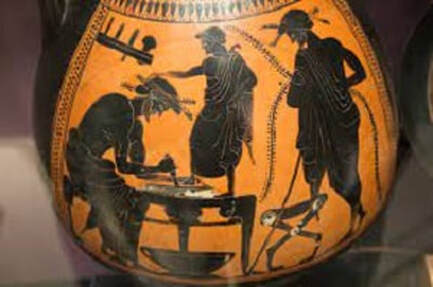 Do you know any ultracrepidarians? And, no, such people are not members of some obscure cult.
Do you know any ultracrepidarians? And, no, such people are not members of some obscure cult.In brief, an ultracrepidarian is a presumptuous person who has no special knowledge of a subject but who expresses strong opinions or advice about it anyway.
Here’s the origin story: A famous painter named Apelles lived in ancient Greece. One day a shoemaker pointed out a defect in Apelles’ depiction of a sandal in a painting. Apelles duly corrected the mistake. Emboldened, the shoemaker began to point out other defects in the painting not related to sandals. Apelles cuttingly replied that the shoemaker should not make judgments ‘beyond the sandal’; i.e., stick to what you know—sandals.
The ancient Greek word for sandal was krepis; in Latin crepida. The Latin phrase ultra crepidam literally means ‘beyond the sandal’. However, over time, ultra crepidam became an expression meaning ‘don’t make judgments about something that you don’t know anything about.’
Image:
A 5th century BCE Athenian shoemaker cuts a piece of leather round the foot of customer.
Image: Ashmolean Museum, Oxford. Athenian black-figure pottery pelike, 5th century BC
https://commons.wikimedia.org/wiki/File:Athenian_black-figure_pelike,_5th_c_BC,_shoemaker,_AshmoleanM,_AN_1986-1908_G.247,_142573.jpg
Reference: Online Etymological Dictionary, https://www.etymonline.com/
https://www.merriam-webster.com/words-at-play/polite-words-for-impolite-people/ultracrepidarian
https://en.wikipedia.org/wiki/Sutor,_ne_ultra_crepidam
Published on January 12, 2024 16:33
January 8, 2024
Book
 Have you ever leafed through a book?
Have you ever leafed through a book?The word book has its origins in the PIE root bhago (beech tree), the source of Latin fagus, the scientific name for the botanical genus of beech trees.
PIE bhago is the source of Proto-Germanic bokiz (beech) and modern German buche (beech) and buchstaben (a beech stick). Beech wood, because of its softness and ease of cutting, was often used as a medium for the use of runes. Runes are any of several alphabets used by Germanic peoples from about the 3rd to the 13th centuries. Perhaps it is not surprising that German Buch (book) comes from buche (beech tree).
Similarly, the French word for book (livre) comes from Latin librum (the inner bark of trees) and from PIE lubh-ro (leaf, rind) and PIE leub(h) (to strip, to peel). The word library also comes from these sources.
The English word book comes from Germanic rather than from Latin sources.
The Old English word boc (book), from Proto-Germanic bokiz, originally meant any written document. Later, the word book came to mean a written work of many pages fastened together and bound. The Old English plural of book was beek, not books—just as geese is the plural of goose.
From bokiz to buch to boc to book—a book literally and figuratively comes from trees. Speaking of leafing through a book.
Perhaps it is not surprising to consider that over the centuries the tree has been a symbol of knowledge. Although this image might have to change if more and more people begin to get their knowledge from YouTube or social media!
Reference: Online Etymological Dictionary, https://www.etymonline.com/
Published on January 08, 2024 11:45
January 5, 2024
Cubbyhole
 Have you ever heard of a cubbyhole? There was a cubbyhole, a word used by my parents, in my bedroom in the war time house in which I grew up.
Have you ever heard of a cubbyhole? There was a cubbyhole, a word used by my parents, in my bedroom in the war time house in which I grew up.My home looked almost exactly like the one in the photo. These war time houses were built quickly and cheaply to provide housing for service personnel returning to Canada after World War Two.
To enter the cubbyhole, I opened a four-foot high door in the wall at the end of my bed and crawled into a narrow space between the bedroom wall and the sloping roof. Sort of like an attic behind the wall rather than an attic above the ceiling. Imagine a triangular-shaped crawl space just above the front windows of the home in the photo.
My parents stored stuff in the cubbyhole—suitcases, a trunk, Christmas décor, boxes full of family memorabilia including my Dad’s air force uniform. My parents did not forbid me to go into the cubbyhole but they didn’t exactly encourage it either. I spent many nights in there as a child with a flashlight looking at things when I was supposed to be in bed.
The word cubbyhole (a small, enclosed space) appears in English in 1825, possibly from cub, a related Low German word from the 1540s meaning a stall, pen, cattle shed, hutch. In the 1650s, a cuddy was a small cabin in a boat, perhaps from Dutch kajuit or French cahute. Another suggestion is that cubbyhole comes from cuddy, a word from 1793 (a small room, cupboard). In brief, the origins of the word cubbyhole are uncertain.
In some countries and US states, the glove compartment in a vehicle is called a cubbyhole. In a kindergarten or daycare centre, a cubbyhole is often the place where kids can keep their belongings. Cubbyhole is a well-known nightclub and hangout in New York City.
Image: War time home: Saskatchewan Council for Archives and Archivists
Reference: Online Etymological Dictionary, https://www.etymonline.com/
Published on January 05, 2024 17:52
January 1, 2024
Janitor
 The word janitor is related the Roman god Janus often portrayed with two faces, one in front and one in back, who is the guardian of doors and gates. Janus is also the patron deity of endings and beginnings; hence the month of January—a month of endings and beginnings.
The word janitor is related the Roman god Janus often portrayed with two faces, one in front and one in back, who is the guardian of doors and gates. Janus is also the patron deity of endings and beginnings; hence the month of January—a month of endings and beginnings.The name Janus has its origins in Latin ianus (gate, arched passageway) and ianua (door, entrance, gate). Latin ianitor means a doorkeeper or porter.
The word janitor came to English in the 1580s meaning an usher in a school. By the 1620s, janitor also meant a doorkeeper.
Janitor, meaning the caretaker of a building or a man employed to see that rooms are kept clean and in order, is from 1708. A woman janitor was known as a janitress (1806) or janitrix (1818).
The word custodian, first seen in 1944 in American English, has gradually replaced the use of the word janitor.
Custodian is the short form of custodian-janitor, a term from 1899. The word custodian first came to English in 1781 meaning a person who has the care or custody of any person, place, or thing. The custodian is most often the person with the keys to a building and the one who controls access in the ‘off-hours’.
Custodian is a neutral term. There is no need to say custodianress or custodiantrix or custodianette.
Image: https://www.ancient-origins.net/myths-legends-europe/janus-figures-0011548
Reference: Online Etymological Dictionary, https://www.etymonline.com/
Published on January 01, 2024 20:20
December 28, 2023
Nifty
 When you hear the word nifty, does the word magnificent come to mind? Maybe. Usually though when we speak of something being nifty we mean some everyday thing that is handy or useful, something that is cleverly devised or attractive.
When you hear the word nifty, does the word magnificent come to mind? Maybe. Usually though when we speak of something being nifty we mean some everyday thing that is handy or useful, something that is cleverly devised or attractive.The word nifty has an unknown origin; perhaps from theatrical slang. Nifty, meaning stylish or good-looking, is first seen in an 1868 poem by the American poet Bret Harte (1836 – 1902) “who said it was a shortened, altered form of Magnificat” (Online Etymological Dictionary).
The word Magnificat has its origins in the Proto-Indo-European (PIE) root meg (great) and Latin magnus (great) + facere (to make, to do) = magnificare (to make something great or magnificent). The word Magnificat came to English around 1200 from the Latin name for New Testament hymn said to be created by Mary, mother of Jesus.
Image: The Nifty Theatre, Waterville, Washington. The US National Register of Historic Places.
Reference: Online Etymological Dictionary, https://www.etymonline.com/
https://en.wikipedia.org/wiki/Nifty_Theatre
Published on December 28, 2023 09:47
December 24, 2023
Yule
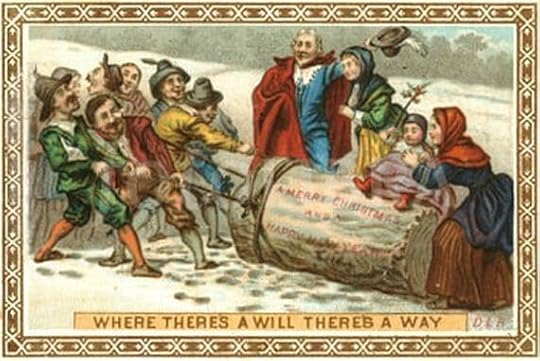 This year, the Yule or Yuletide, is from 21 December to 1 Jan. Yule is said to be one of the oldest traditional pre-Christian celebrations in Northern Europe.
This year, the Yule or Yuletide, is from 21 December to 1 Jan. Yule is said to be one of the oldest traditional pre-Christian celebrations in Northern Europe.The word Yule and the meaning and practices of Yule can be traced back to the traditions of ancient Indo-European peoples. For example, ancient Persian yaldag means yule day. Yalda is now the name for the Persian winter solstice festival.
Some sources suggest that when ancient Indo-Europeans migrated into what is now Scandinavia about 4,000 years ago, they displaced or became integrated with the original indigenous peoples. One theory suggests that one of the aboriginal words which was taken into the Indo-European languages was Yehwla, the name for the midwinter solstice.
Yehwla is thought to be the source of Old Norse jol which in turn is the source of Old English geol, geola (Christmas Day, Christmastide) and the English word Yule. Some sources suggest that Old Norse jol is also the source of Old French jolif which later became the word jolly (which originally meant festive).
So, there are many theories for the ancient origins of the word Yule—all interesting in themselves but none that are known for certain.
In Anglo-Saxon Christianity, the word Yule came to mean the twelve-day December feast of the Nativity. Does the song, “Twelve Days of Christmas” come to mind? By the 11th century, the word Christmas replaced Yule except for places in northeast English where the predominant Danish settlers continued to use the word Yule.
The word Yuletide is from the late 15th century. The first reference to a Yule log is from the 17th century. The word Yule referring to Christmas was revived in England in the 19th century.
Yule logs and yule log cakes? Traditionally, families would put one end of a very large log into the household fireplace and keep it burning during the 12 days of Christmas. As this tradition became increasingly impractical, families turned instead to the production of yule log cakes which I suspect most would agree is a much better (and tastier) idea.
Reference: Online Etymological Dictionary, https://www.etymonline.com/
https://en.wikipedia.org/wiki/Yule
Published on December 24, 2023 10:38
December 21, 2023
Mistletoe
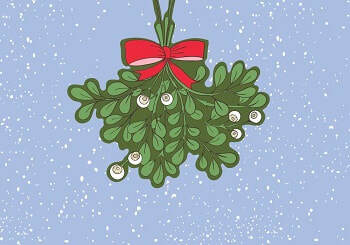 Well, here’s a bit of a surprise. The word mistletoe may be related to the Proto-Indo-European (PIE) root meigh (to urinate)! The origins of the word mistletoe are unknown; however, one suggestion is that the mistletoe plant is propagated through the droppings of the missel thrush or missel-bird. These droppings are called mih-stu- (urine), a Germanic term from PIE meigh.
Well, here’s a bit of a surprise. The word mistletoe may be related to the Proto-Indo-European (PIE) root meigh (to urinate)! The origins of the word mistletoe are unknown; however, one suggestion is that the mistletoe plant is propagated through the droppings of the missel thrush or missel-bird. These droppings are called mih-stu- (urine), a Germanic term from PIE meigh.The word mistletoe is first seen in the Proto-Germanic mikhstilaz (mistletoe) and Old English mistel (basil, mistletoe) and mistiltan (mistle twig). Mistletoe is a European plant which grows parasitically on certain trees.
Mistletoe was venerated by the Druids of ancient Britain. The white berries were considered symbols of male fertility (i.e., semen). The ancient Romans hung mistletoe over doorways as a symbol of peace, love, and understanding as well as for protection of the household. Mistletoe was part of the Roman Saturnalia celebrations. Christian Christmas celebrations continued this tradition. The custom of kissing under the Christmas mistletoe appears to have originated in the late 18th or early 19th centuries among the servants of English country houses.
Reference: Online Etymological Dictionary, https://www.etymonline.com/
Published on December 21, 2023 07:59
December 18, 2023
Poinsettia
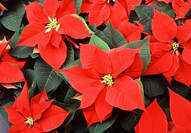 The poinsettia gets its name from Joel R. Poinsett (1770 – 1851), the first US Ambassador to Mexico. He brought this plant to the attention of botanists in 1828. He was also a co-founder of what later became known as the Smithsonian Institute.
The poinsettia gets its name from Joel R. Poinsett (1770 – 1851), the first US Ambassador to Mexico. He brought this plant to the attention of botanists in 1828. He was also a co-founder of what later became known as the Smithsonian Institute.Originally, poinsettias were cultivated by the Aztecs for use in traditional medicine. Today, over 70 million poinsettias are sold in the US during the Christmas season in the US and millions more in other countries.
Reference: Online Etymological Dictionary, https://www.etymonline.com/
Published on December 18, 2023 11:53



